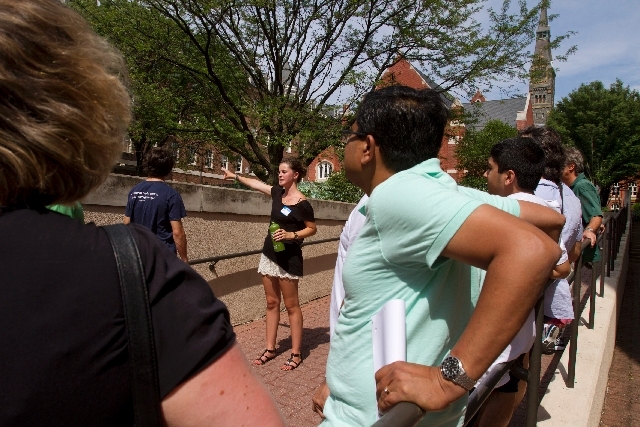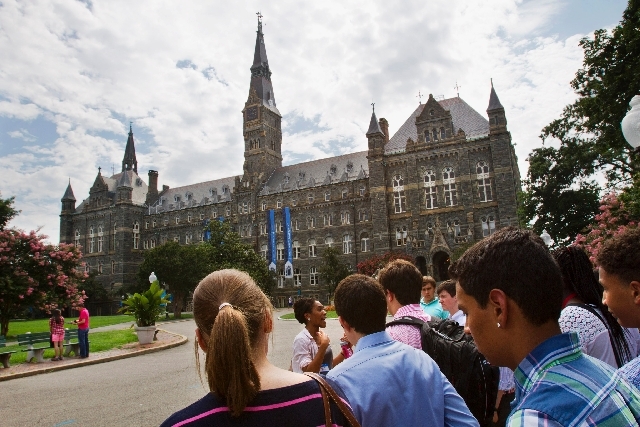Grants, scholarships key to paying for college
WASHINGTON — Grants and scholarships are taking a leading role in paying college bills, surpassing the traditional role parents long have played in helping foot the bills, according to a report from loan giant Sallie Mae.
Since the recession, more college-bound students have eliminated schools from their searches based on costs and have relied less on their parents once they get to campus, said the report released Tuesday. Worries such as tuition increases and job losses seem to have faded as the economy has improved, yet parents and students still make decisions on schools, majors and work schedules based on the price tag.
“We have moved into a post-recession reality in how people pay for college,” said Sarah Ducich, Sallie Mae’s senior vice president for public policy.
College spending per student was about $21,000 during 2012, down from a peak of $24,000 in 2010, according to the Sallie Mae-Ipsos Public Affairs report.
The annual survey of student financial aid found students earned about $6,300 in grants and scholarships to pay for college costs, taking the top spots from parents. Student loans were the third most common source to pick up the bill for courses, housing and books.
The average student borrowed $8,815 in federal loans.
The rate for those loans was the subject of debate in the Senate last week, as lawmakers considered a compromise that would offer some students lower rates for the next few years but would prescribe higher rates for future classes. The Senate is expected to vote on that compromise this week.
Last year, the average family turned to grants and scholarships to cover 30 percent of college costs. Parents’ income and savings covered 27 percent of the bill and student borrowing covered 18 percent.
“Parents are willing to stretch themselves,” Ducich said “It’s not that they’re willing to pay. It’s that their income is not keeping up.”
Parents’ enthusiasm for college has not shriveled, though. The survey found 85 percent of parents saw college bills as an investment in their children’s future.
“We’re in a new normal where big ticket items like college, families will pay for them but won’t stress about them too much,” said Cliff Young, managing director at Ipsos.
One-fifth of parents added work hours to pay for college and half of students increased their work hours, too. The report found 57 percent of families said students were living at home or with relatives, up from 41 percent last year and 44 percent in 2011.
Among other strategies employed to deal with costs:
— One-fifth of students from low-income families chose to transfer to less expensive schools.
— About one-fifth of students said they changed majors to fields that were expected to be more marketable upon graduation.
— In all, 67 percent of students and their families eliminated colleges at some stage during the application process because of costs, up from 58 percent in 2008.
“It forced them to adopt new behaviors of savings and ways to find nickels and dimes,” Young said.
The tuition sticker price at public four-year colleges is up 27 percent beyond overall inflation over the last five years, according to the latest figures from a separate study from the College Board. This past year it rose nearly 5 percent to an average of $8,655 nationwide. Including room and board, the average sticker price at public colleges is now $17,860, and students pay on average $12,110. At private four-year colleges, the average full tuition price is now just under $40,000, with the average student paying $23,840.
What does that mean for the average college student?
About two-thirds of the national college class of 2011 had loan debt at graduation, and their debt averaged $26,600, according to the most recent figures from the California-based Institute for College Access and Success. That was an increase of about 5 percent from the class before them.
The Ipsos telephone poll was conducted between April 10 and May 9 with 1,802 parents of undergraduate students and 800 18- to 24-year-old undergraduate students. The survey has a margin of error of plus or minus 2.5 percentage points.
———
Follow Philip Elliott on Twitter: http://www.twitter.com/philip—elliott

New freshmen attend orientation at UNLV in May.
UNLV COSTS
Projected total cost for a resident student attending UNLV for the 2013-14 school year:
— $23,150 for an undergraduate living off campus
— $21,880 to live on campus
— $17,345 to live at home and commute
Source: Norm Bedford, director of the Office of Financial Aid & Scholarships at UNLV
A UNLV student living off campus will pay $6,872 in tuition and fees for 15 units, $4,806 for rent and utilities, another $4,309 for food, $1,400 for books and supplies, $2,837 for transportation and $2,926 in personal expenses, totaling $23,150, according to a cost estimate on UNLV’s website.
— CHRIS SIEROTY
RELATED STORY























